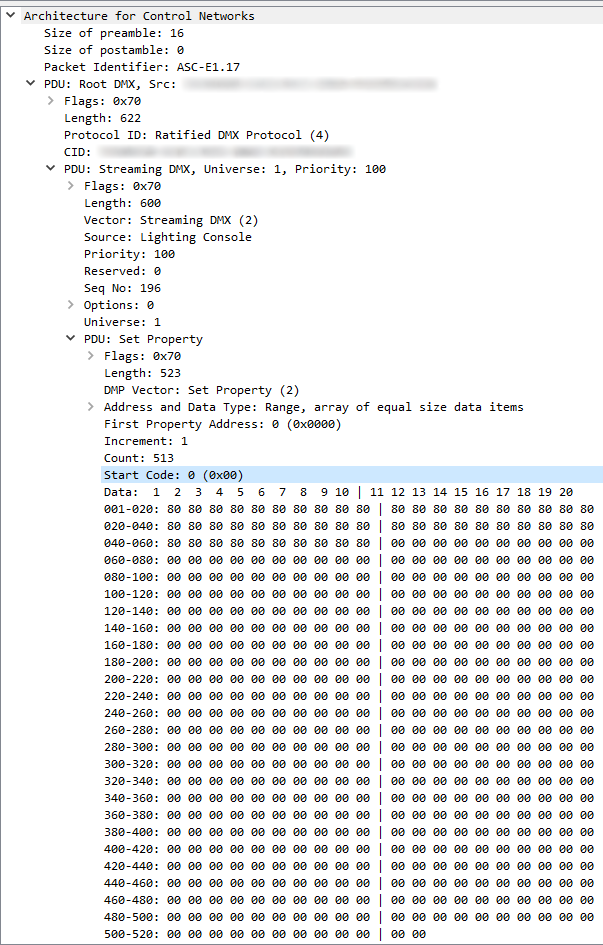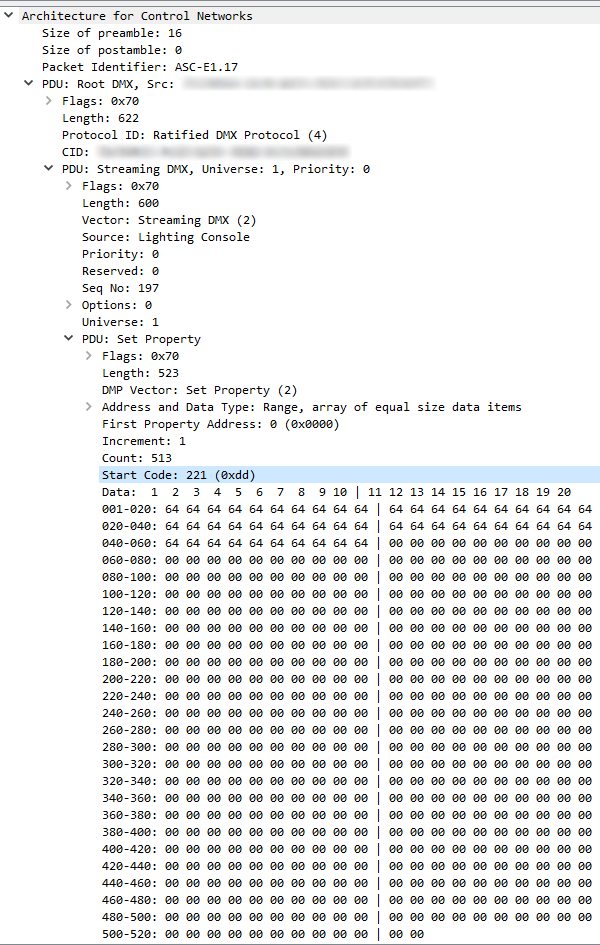Elation eNode Flickers When Receiving sACN Data from ETC Console or ETCnomad
Symptoms/Issue
When using sACN output from an ETC console or ETCnomad connected to an Elation eNode, addresses patched in the console/ETCnomad flash between the desired level and a seemingly random level above or below the desired level.
Description/Explanation of Issue
ETC Consoles and ETCnomad software implement an extension to the ANSI E1.31 sACN standard that defines the ability to assign a priority on a per-address basis instead of only a per-source basis. This extension uses an alternate start code (0xdd) to indicate that the data included in the packet is not level data and should not be treated as level information. Not all manufacturers are required to implement all extensions to the standards, but because only the start code changes, the rest of the data can look very much like level data and it would seem that the Elation eNode firmware as of 10/23/2019 does not read the start code and distinguish between data that is intended to be level data and data that is not.
sACN DMX Level Packet (Wireshark Capture)

sACN Per-Address Priority Packet (Wireshark Capture)

Fix/Solution
- Use ArtNet protocol instead of sACN as ArtNet does not have the same alternate start code or priority structure.
- Contact Elation to determine if a firmware update is available to resolve this issue: https://www.elationlighting.com/contact
Related Links/References
ANSI E1.31 — 2018 Entertainment Technology Lightweight streaming protocol for transport of DMX512 using ACN
(https://tsp.esta.org/tsp/documents/published_docs.php)
7.6 Property Value Count
The DMP Layer's Property Value Count is used to encode the number of DMX512-A [DMX] Slots (including the START Code slot).
7.7 Property Values (DMX512-A Data)
The DMP Layer's Property values field is used to encode the DMX512-A [DMX] START Code and data.
The first octet of the property values field shall be the DMX512-A [DMX] START Code.
The remainder of the property values shall be the DMX512-A data slots. This data shall contain a sequence of octet data values that represent a consecutive group of data slots, starting with slot 1, from a DMX512-A packet. The number of data slots encoded in the frame shall not exceed the DMX512-A limit of 512 data slots.
Processing of Alternate START Code data shall be compliant with ANSI E1.11 [DMX] Section 8.5.3.3 -Handling of Alternate START Code packets by in-line devices.
ANSI E1.11 – 2008 (R2018) Entertainment Technology—USITT DMX512-A Asynchronous Serial Digital Data Transmission Standard for Controlling Lighting Equipment and Accessories
(https://tsp.esta.org/tsp/documents/published_docs.php)
8.5.3.3 Handling of Alternate START code packets by in-line devices
DMX512 processing devices or any device that receives and re-transmits DMX512 shall state in the manual for the product how they process Alternate START Code packets. The acceptable processing methods are:
1) Block all packets containing particular Alternate START Codes. The START Codes blocked shall be declared (and may be all Alternate START Codes).
2) Pass unmodified all packets containing particular Alternate START Codes. The START Codes passed shall be declared.
3) Process the information contained in packets containing particular Alternate START Codes. The algorithm shall be declared in enough detail to allow the user to decide if the device will satisfy their needs.
DMX512 in-line repeating transmitters shall not pass some packets with a particular Alternate START Code while blocking other packets containing the same Alternate START Code unless doing so as part of a stated processing algorithm.
8.5.4 START code processing
All receiving devices other than in-line processing devices shall process the START Code and differentiate between those packets with NULL START Codes and those with Alternate START Codes. Devices shall not ignore START Codes by assuming that all packets received are NULL START Code packets.
